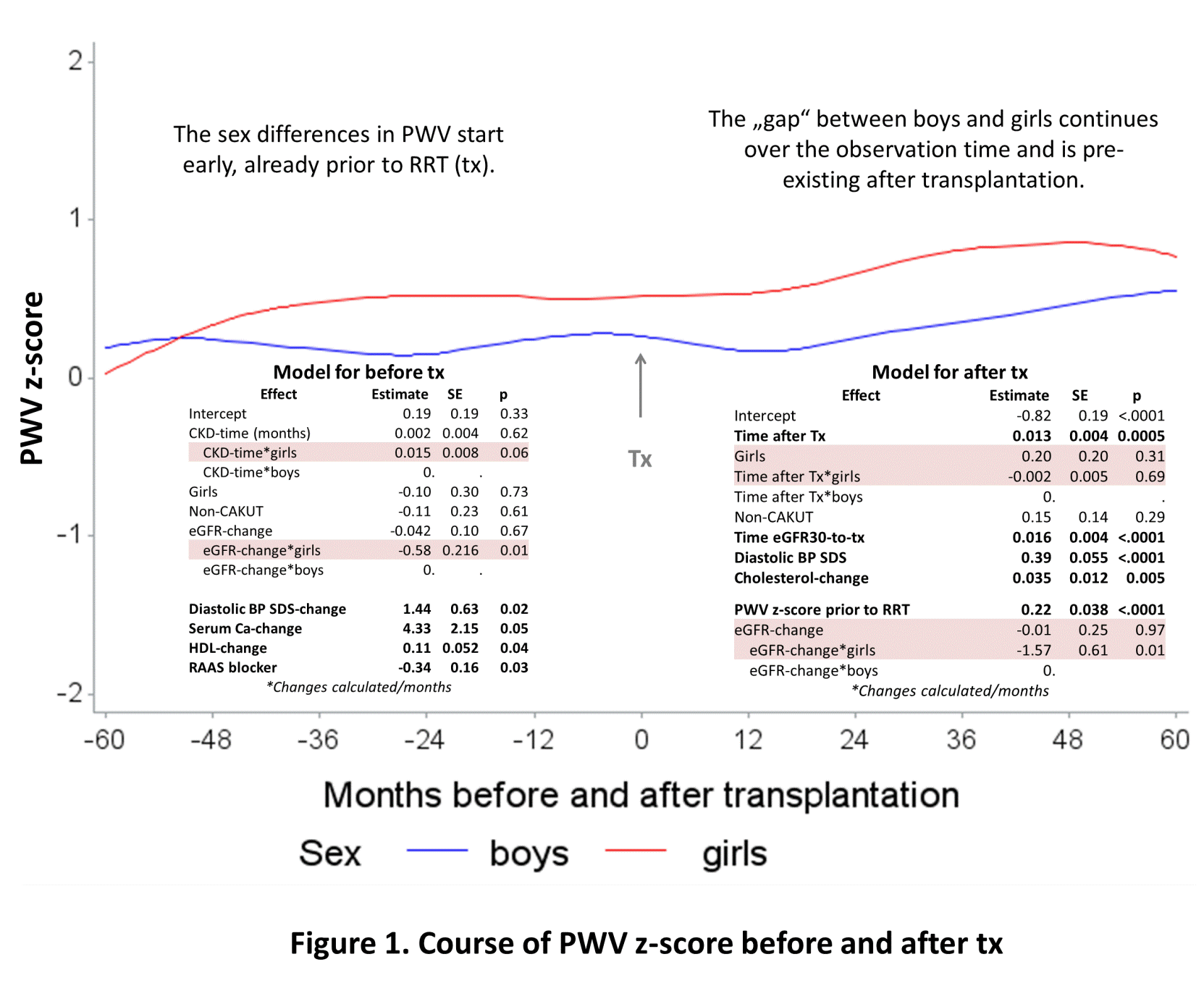Differences in pulse wave velocity between transplanted boys and girls: Longitudinal analysis of 4C-T study
Rizky I. Sugianto1, Bernhard M. W. Schmidt2, Anke Doyon3, Daniela Thurn1, Nima Memaran1, Karolis Azukaitis3, Elke Wühl3, Franz Schaefer3, Anette Melk1.
1Pediatric Nephrology, Hannover Medical School, Hanover, Germany; 2Nephrology, Hannover Medical School, Hanover, Germany; 3Pediatric Nephrology, Heidelberg University Hospital, Heidelberg, Germany
4C Study.
Background: Mortality rates in children with end stage renal disease (ESRD) are higher in girls1. Cardiovascular complications are among the most common causes of death2. Pulse wave velocity (PWV), a measure of aortic stiffness, is associated with mortality in adults with ESRD. We investigated whether sex differences in aortic PWV were present in children who underwent tx in the 4C study.
Method: Of 336 children undergoing RRT, 236 (156 boys) received tx and were longitudinally analyzed. PWV was normalized for sex and height; systolic and diastolic blood pressure (BP) for age, sex, and height.
Results: Whereas PWV z-scores did not differ between girls and boys as they entered chronic kidney disease (CKD) stage 4 (boys=0.18±1.6 and girls=0.18±1.9), PWV was higher in girls at the last visit before start of RRT (0.45±1.9 vs. 0.25±1.5) and three years after tx (0.83±1.3 vs. 0.30±1.1). We did not find sex differences in the mean time between reaching eGFR ≤30 ml/min/1.73m2 to tx or the months on dialysis. At inclusion eGFR was similar (boys=24.3±8.7; girls=23.4±8.2 ml/min/1.73m2), but the current rate of eGFR loss at the last visit before RRT start was greater in girls than in boys (-0.42±0.48 vs -0.33±0.57 ml/min/1.73m2 per month).
A stratified analysis of the time periods before and after tx disclosed an association of PWV increase with eGFR decline prior to RRT in girls (an average eGFR decline of -1 ml/min/1.73m2/month within the period before RRT start was associated with an increase of 0.58 PWV). Further independently associated factors contributing to higher PWV were increasing diastolic BP z-score (DBP), serum calcium, and HDL, whereas RAAS blockers had a protective effect.
In the model after tx, the higher PWV in girls after transplantation was explained by the faster eGFR decline in girls prior to tx. Further factors associated with higher PWV were longer time after tx, higher DBP, larger cholesterol increase and higher PWV at last visit prior to RRT.
Discussion: Girls with advanced CKD show more pronounced aortic stiffening when compared to boys, leading to a significant sex difference that persists after tx. This difference could explain the higher mortality rate seen in girls with ESRD.

[1] Ahearn P, Johansen KL, McCulloch CE, et al. Sex disparities in risk of mortality among children with ESRD. Am J Kidney Dis. 2019;73(2):156-162.
[2] Mitsnefes MM. Cardiovascular disease in children with chronic kidney disease. J Am Soc Nephrol 2012; 23: 578.